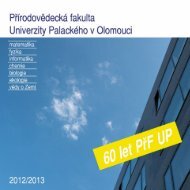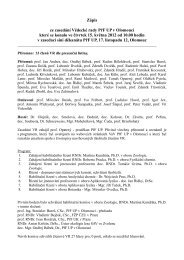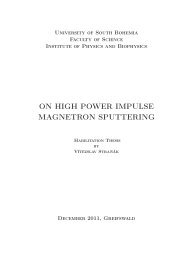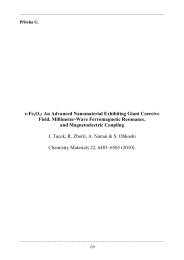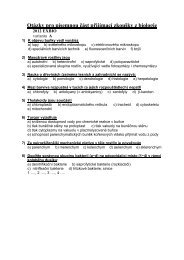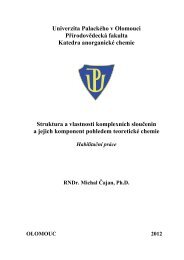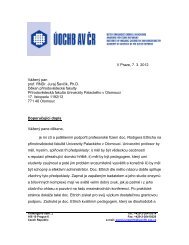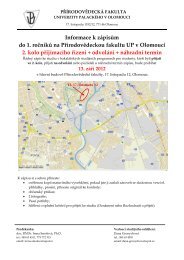A comparative structural analysis of direct and indirect shoot ...
A comparative structural analysis of direct and indirect shoot ...
A comparative structural analysis of direct and indirect shoot ...
You also want an ePaper? Increase the reach of your titles
YUMPU automatically turns print PDFs into web optimized ePapers that Google loves.
Stress MAP kinase SIMK in plant tip growth<br />
et al., 2000), N103 speci®cally recognized activated SIMK<br />
(data not shown). These data show that N103 antibody is<br />
suitable for studying activated SIMK.<br />
In root tips, SIMK is predominantly nuclear in stele <strong>and</strong><br />
cortex tissues, but is more abundant in epidermal cells<br />
(BalusÏka et al., 2000b). Cytological <strong>analysis</strong> <strong>of</strong> longitudinal<br />
sections from the root transition <strong>and</strong> elongation<br />
zones revealed that SIMK was mostly present in nuclei <strong>of</strong><br />
epidermal cells (arrows in Figure 1C <strong>and</strong> D). SIMK<br />
showed a spot-like nuclear staining, but was not detected<br />
in nucleoli (stars in Figure 1C). An immunodepletion<br />
control in which the SIMK antibody was pre-incubated<br />
with the FNPEYQQ heptapeptide con®rmed the speci®city<br />
<strong>of</strong> labeling in roots (Figure 1E <strong>and</strong> F).<br />
When root hair formation was analyzed, SIMK was<br />
found to accumulate in outgrowing bulges <strong>and</strong> at root hair<br />
tips (Figures 1G±I <strong>and</strong> 2E). SIMK accumulated in distinct<br />
spots at the cell periphery facing the outer tangential cell<br />
wall <strong>of</strong> trichoblast (Figure 1G) marking the site <strong>of</strong> bulge<br />
outgrowth. During bulge formation, SIMK showed strong<br />
association with cell periphery-associated spots <strong>of</strong> the<br />
bulge (Figure 1H). In growing root hairs, SIMK was found<br />
to accumulate within root hair tips <strong>and</strong> in spot-like<br />
structures in the root hair tube (Figure 1I). This pattern<br />
<strong>of</strong> SIMK distribution along root hairs was con®rmed by<br />
semi-quantitative measurements <strong>of</strong> ¯uorescence intensity<br />
(data not shown). Using phospho-speci®c N103 antibody,<br />
activation <strong>of</strong> SIMK was observed during root hair<br />
formation. In root epidermal cells, only very weak labeling<br />
was found (Figure 1J <strong>and</strong> K). In growing root hairs, active<br />
SIMK accumulated in root hair tips in the form <strong>of</strong> distinct<br />
spots (Figure 1L). An immunodepletion control in which<br />
the N103 antibody was pre-incubated with the<br />
CTDFMTpEYpVVTRWC peptide revealed no labeling<br />
in roots <strong>and</strong> con®rmed the speci®city <strong>of</strong> N103 antibody<br />
(Figure 1M). These data show that accumulation <strong>of</strong> active<br />
SIMK in root hair tips correlates with root hair formation.<br />
SIMK co-localizes with F-actin meshworks in<br />
root hair tips <strong>and</strong> with F-actin cables after<br />
jasplakinolide treatment<br />
Actin ®laments, but not microtubules, are abundant at tips<br />
<strong>of</strong> growing root hairs (Bibikova et al., 1999; Braun et al.,<br />
1999; Miller et al., 1999) <strong>and</strong> are involved in root hair<br />
initiation <strong>and</strong> polar growth (BalusÏka et al., 2000a).<br />
Because SIMK can associate with mitotic but not cortical<br />
microtubules <strong>of</strong> dividing cells under certain circumstances<br />
(BalusÏka et al., 2000b), we also investigated whether<br />
SIMK co-localized with microtubules in growing root<br />
hairs. We did not ®nd co-localization <strong>of</strong> SIMK with<br />
microtubules in root hair apices <strong>and</strong> in root hair tubes<br />
(Figure 2A±C). In order to study a possible SIMK<br />
association with actin ®laments, we performed co-localization<br />
studies <strong>of</strong> actin <strong>and</strong> SIMK in growing root hairs<br />
(Figure 2D±F) <strong>and</strong> root hairs treated with actin drugs<br />
(Figure 2G±L). SIMK co-localized with the dense F-actin<br />
meshwork at root hair tips (Figure 2F, arrowheads) <strong>and</strong> in<br />
spots along longitudinal cables <strong>of</strong> actin ®laments in<br />
subapical <strong>and</strong> deeper portions <strong>of</strong> growing root hairs.<br />
These data suggest that SIMK is associated with both the<br />
actin cytoskeleton <strong>and</strong> vesicular compartments in root<br />
hairs.<br />
To gain further insight into the importance <strong>of</strong> F-actin<br />
<strong>and</strong> apical SIMK localization, roots were treated with<br />
latrunculin B (LB), an inhibitor <strong>of</strong> actin polymerization<br />
(Gibbon et al., 1999; BalusÏka et al., 2000a), or with<br />
jasplakinolide, an F-actin-stabilizing drug (Bubb et al.,<br />
2000). We performed time course experiments with these<br />
drugs followed by co-localization <strong>of</strong> actin <strong>and</strong> SIMK<br />
within bulges <strong>and</strong> root hairs. After treating roots for 30 min<br />
with LB, effective depolymerization <strong>of</strong> F-actin was<br />
observed in bulging trichoblasts. Under these conditions,<br />
SIMK disappeared from periphery-associated spots <strong>of</strong> root<br />
hair bulges <strong>and</strong> relocated to the nucleus (data not shown).<br />
In growing root hairs treated with LB, ¯uorescent spots<br />
presumably representing G-actin or patches <strong>of</strong> fragmented<br />
F-actin were distributed evenly over the entire length <strong>of</strong><br />
the root hairs (Figure 2G). In root hair apices, LB<br />
treatment resulted in disintegration <strong>and</strong> depletion <strong>of</strong><br />
dense apical F-actin meshworks (Figure 2G). The most<br />
intense SIMK labeling <strong>of</strong> LB-treated root hairs was found<br />
invariably within nuclei <strong>and</strong> nucleoli (Figure 2H),<br />
as revealed by nuclear 4¢,6-diamidino-2-phenylindole<br />
(DAPI) staining (Figure 2I).<br />
To study the association <strong>of</strong> SIMK with F-actin in more<br />
detail, root hairs were treated with jasplakinolide.<br />
Jasplakinolide-induced stabilization <strong>of</strong> F-actin was accompanied<br />
by the appearance <strong>of</strong> thick F-actin cables protruding<br />
into the extreme root hair tips (Figure 2J). In<br />
jasplakinolide-treated root hairs, SIMK co-localized<br />
extensively with these thick F-actin cables (Figure 2K<br />
<strong>and</strong> L). Besides this, SIMK was also located to individual<br />
spots within the cytoplasm (Figure 2K <strong>and</strong> L). These data<br />
suggest that drugs affecting the organization <strong>and</strong> dynamics<br />
<strong>of</strong> the F-actin cytoskeleton (the G-actin/F-actin ratio) have<br />
a <strong>direct</strong> impact on the intracellular localization <strong>of</strong> SIMK.<br />
SIMK is associated with vesicular traf®c in<br />
root hairs<br />
Besides co-localization with tip-focused F-actin meshworks,<br />
SIMK was found in distinct spots along the entire<br />
length <strong>of</strong> the root hair (Figures 1 <strong>and</strong> 2). To investigate<br />
further the vesicle-associated localization <strong>of</strong> SIMK, we<br />
used brefeldin A (BFA) as an ef®cient inhibitor <strong>of</strong><br />
vesicular traf®cking in plant cells (Satiat-Jeunemaitre<br />
et al., 1996). Upon BFA treatment, the apical dense<br />
meshworks <strong>of</strong> F-actin in growing root hairs disappeared<br />
(Figure 2M) <strong>and</strong> SIMK was located throughout the root<br />
hair cytoplasm in spotty <strong>and</strong> patchy structures <strong>of</strong> variable<br />
sizes (Figure 2N). These BFA-induced patches were<br />
distributed along F-actin (Figure 2O), indicating that the<br />
actin cytoskeleton might be important for their formation.<br />
The tip-focused gradient <strong>of</strong> SIMK <strong>and</strong> F-actin was lost in<br />
root hairs treated with BFA (Figure 2N <strong>and</strong> O). These<br />
results suggest that vesicular traf®cking is involved in the<br />
control <strong>of</strong> SIMK distribution in root hair tips.<br />
Jasplakinolide <strong>and</strong> latrunculin B induce activation<br />
<strong>of</strong> SIMK in cultured root cells<br />
In order to investigate a possible role for the actin<br />
cytoskeleton on SIMK activity, we tested two actin drugs<br />
for their effects on SIMK activity in root-derived suspension<br />
cultured cells. Immunokinase <strong>analysis</strong> revealed that<br />
both jasplakinolide (5 mM) <strong>and</strong> LB (10 mM) activate SIMK<br />
(Figure 3, uper panel). After treating cells with LB, SIMK<br />
3299





